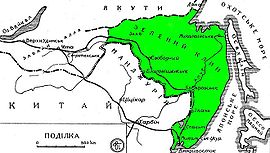- Green Ukraine
-
Green Ukraine Flag of Green Ukraine. A map of the Green UkraineZeleny Klyn (Ukrainian: Зелений клин, Russian: Зеленый Клин), also known as the Green Ukraine is a historical Ukrainian name of the land in the Russian Far East area between the Amur River and the Pacific Ocean.
After the Russian Revolution of 1917, The Ukrainian Republic of the Far East[citation needed] or Green Ukraine[citation needed] was a projected country in the Russian Far East.
After the Bolshevik Far Eastern Republic was established on April 6, 1920, Far Eastern areas with an ethnic Ukrainian majority attempted to secede and establish an entity called Green Ukraine[citation needed]. The movement quickly proved abortive.
Contents
Historical outline
- 24 June 1917 -First All-Ukrainian Far Eastern Congress at Nikolsk-Ussuriysky formed the Far Eastern Kray Rada (Land Council).
- Jan 1918 - Second All-Ukrainian Far Eastern Congress at Khabarovsk. Green Ukraine was proclaimed as part of Ukrainian State in spite of the lack of geographical connection.
- Apr 1918 - The Third All-Ukrainian Far Eastern Congress asked for creation of an independent Ukrainian state on the Pacific Ocean.
- 1918 - Created the Far Eastern Ukrainian troops (more 5000) by general Khreschatitsky, B.R.
- 11 April 1920 - Order of Hetman G. Semyonov about the right of Far Eastern Ukrainians for national self-determination and autonomy in the limits of united Far Eastern state of Cossacks, Buryats, and Ukrainians
- 1922 - Dissolved.
Head of the Kray Secretariat
- June 1918-1919 - Yuri Mova-Glushko (1st time)
- January 1920-1922 - Yuri Mova-Glushko (2nd time)
Territory
Near the Amur River, Ussuriland, around Khabarovsk and north of Vladivostok.
Creed
Most of the Slavic population were Christians. The local Tungusic tribesmen followed local religions and there were also some Yiddish Jews who practiced the Jewish faith as well.
Hydrography
It would have had a coastline similar to that of the Far Eastern Republic.
History of settlement
The Zeleny Klyn (Ukrainian: Зелений клин), Zelena Ukraina or Eastern Ukraina was an area of land settled by Ukrainians which is a part of the Russian Far East in the area of the Amur River and the Pacific Ocean. It was named by the Ukrainian settlers. The territory consists of over 1,000,000 square kilometres and has a population of 3.1 million (1958). The Ukrainian population in 1897 made up 15% of the Primorskaya Oblast's population.[1]
Zeleny Klyn became part of the Russian Empire much later than Siberia and other part of the Far East. The first attempts at colonizing the area date back to the mid 17th century when Khabarov founded the fort of Albazin on the Amur River. From that time, constant skirmishes took place with the Manchu people of China. In 1689, the Treaty of Nerchinsk was signed, which only gave Russia limited territory.
In the mid 19th century, the second Russian expansion took place after Russia lost the Crimean War (1853–1856). A number of Cossack settlements were established on the Amur river. China was far weaker than Russia at the time and ceded territory to Russia in the Treaty of Aigun of 1858 and the Convention of Peking of 1860 (see Amur Annexation).
During this period only a small number of settlers settled in the region consisting of some 14,000 Cossacks and 2,500 Russian soldiers. In 1861 two oblasts were established, the Primorsky and Amur. Vladivostok was founded in 1860, Khabarovsk in 1858.
In 1882 free transportation was announced for settles to the area from Ukraine and free land was offered to settlers. Boatloads of settlers departed from the Ukrainian port of Odessa. By 1897 the population had increased to 310 000. With the establishment of the railroad in 1901 over 14 000 settlers were moving to the area per year, with a maximum of 78 000 settlers moving there in 1907.
In 1914, the area came under the jurisdiction of admiral Kolchak. In 1920, the Far East Republic was established which became a buffer republic between Russia and Japan. In 1922 the republic joined with the Russian Soviet Federative Socialist Republic. In 1934 the Jewish Autonomous Oblast region was established with its capital at Birobidzhan.
See also
- Allied intervention in the Russian Civil War
- Siberian Intervention
- Far Eastern Republic
- Siberian Intervention
- Ukrainians in Russia
- Primorsky Krai
- Lemko-Rusyn republic.
- Siberian Republic.
Sources
Encyclopedia of Ukraine, Volume 2, Paris 1957
References
External links
Categories:- 1922 in the Soviet Union
- 1922 disestablishments
- History of the Russian Far East
- Ukrainian diaspora in Russia
- Ukrainian-speaking countries and territories
- Areas of traditional spread of Ukrainians and Ukrainian language
Wikimedia Foundation. 2010.




